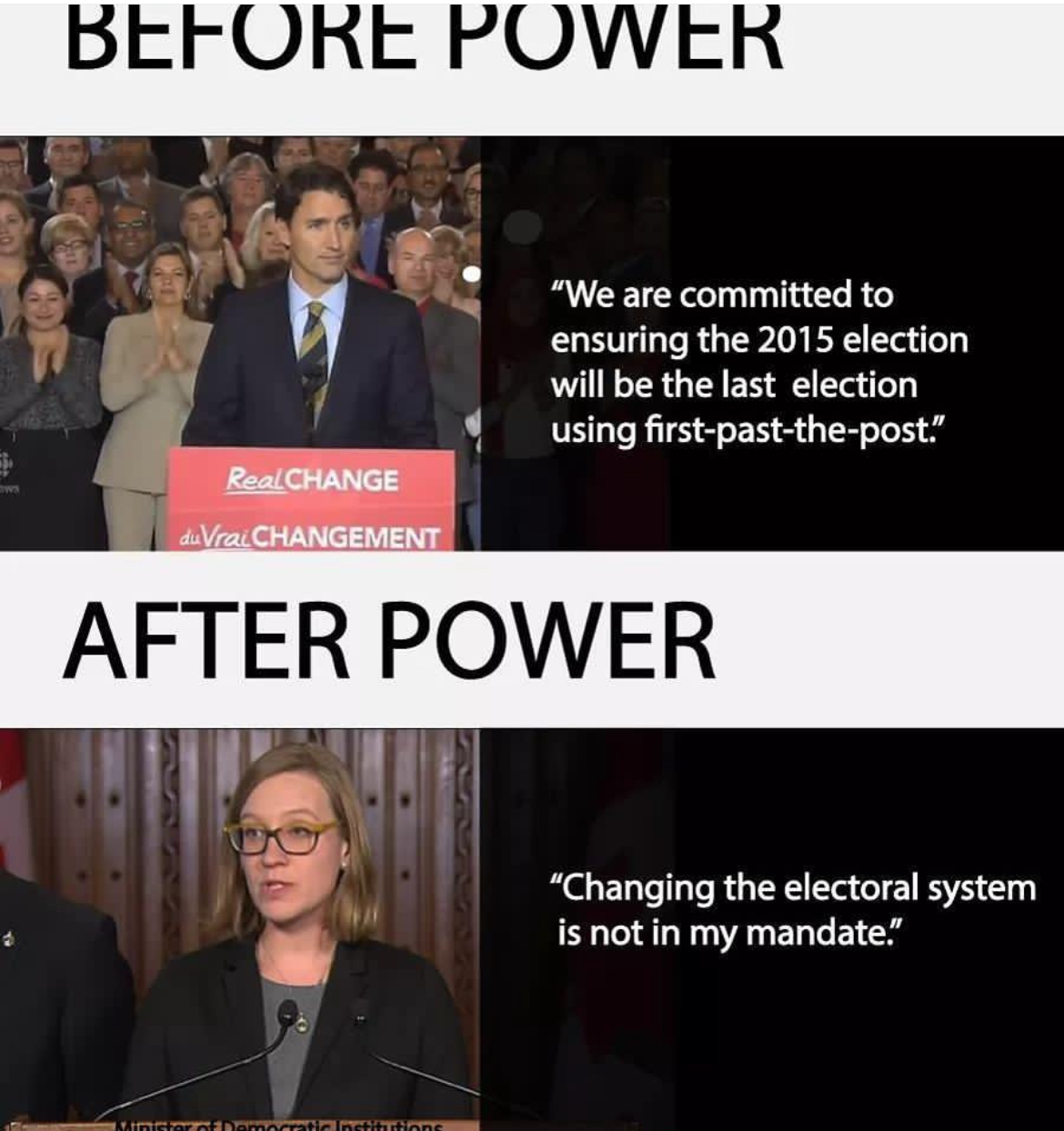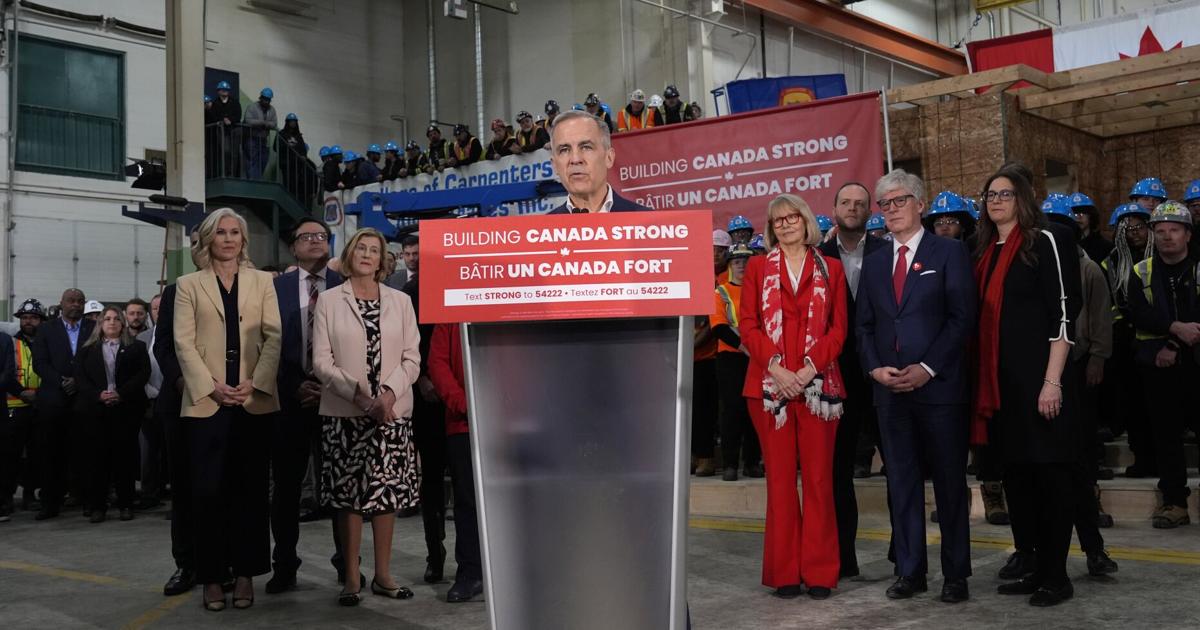Anytime someone wants to build housing, they better be increasing regulations to prohibit investment housing. Housing is meant to give people shelter and home, not make investors rich.
As you’d expect from the central banker whiz kid, he has creative policy ideas. I’m pretty excited to see the budget split into separate maintenance and investment budgets if he gets in, and now this.
That being said, there’s definite notes of what Gould was talking about here. It’s just way, way more focused and detailed. I’d give a summery, but the CBC version, at least, already feels like a summery.
I listened to his speech. He’s talking in no uncertain terms that he’s going for a post-war style build-out. He also pointed out that the market hasn’t delivered and won’t solve our housing crisis.
This is exactly what’s need on high level.
I agree, but I’m also acutely aware that it is campaign season, and the LPC has a nasty habit of running left and governing right.
If we wind up with a Liberal minority with Conservatives in opposition, or with a Liberal majority, I honestly fully expect this to get dropped or strategically undermined the way electoral reform did.
In other words, we’re gonna have to be ready to fight for it.
100%
That said, I think there’s a better chance this to materialize because I think Carney knows he’ll lose the next election if he doesn’t deliver on this file. This isn’t 2015 when things were not great but tolerable. We have a huge homeless population which is not limited to the largest cities anymore, and the cost of housing is hitting every part of the economy. The knife has hit the bone for way more people today than even a few years ago. So while I completely agree with the skepticism, I have a sliver more optimism this time around.
I’ve been concerned that we might get a giant influx of Americans, who have more purchasing power with that strong USD and would price Canadians out of any and all housing. Plus building aggressively like this is a good stimulus to the economy. Let’s hope it works.
I mean, pretty much everything else the Liberals promised has at least been attempted. They’ve gone extra ambitious on some things, even, like doubling their tree planting goal because they were ahead of schedule.
Main exception being voting reform.
I did say everything else.
deleted by creator
It’s a breath of fresh air to hear an actual plan that sounds like it would actually work. This is what Carney is here for.
The fact that they’re creating a crown corporation to build homes on public and private land is huge. This includes prefab and modular homes too. They’re even committing to using Canadian lumber.
We cannot contunue to rely on capitulating to and deregulating private developers and expecting them to act in any way other than own self-interest. They have no incentive to bring down the cost of homes. It is now crystal clear that the neo-liberal solution does not work.
A crown corporation that exists to create housing rather than maximize shareholder value is a massive step in the right direction. Frankly, I’m surprised Carney is doing this but happy about it all the same.
I expect Carney to get pushback from Doug Ford who is firmly in the pocket of private real estate investors.
We cannot contunue to rely on capitulating to and deregulating private developers and expecting them to act in any way other than own self-interest. They have no incentive to bring down the cost of homes. It is now crystal clear that the neo-liberal solution does not work.
I’m hoping to see more details about how production will be split. The article/release describes the new organization as both overseeing and building. I really want the emphasis to be on building, since that will allow them to push down sale or rental costs of the final product. .
There is no significant amount of federal public land sitting unused where people want to live. Only 4% of the total land in the provinces are federally owned, and most of that is parks and military bases.
The provinces themselves have some public land, but even most of that isn’t in or near cities where people want to live. They could build entirely new cities from scratch in slightly less desirable locations, but that’s about it.
The cost to buy private land to do this would be impossibly expensive.
It’s a great concept, but it simply doesn’t work in reality.
Redeveloping public owned lands in cities should be a start. I’ve been to community meetings to discuss redeveloping federal land in Ottawa.
Ottawa has a significant amount of federal land. Transforming unused federal office space to mixed used residential will be a game changer.
There is a crown corp that now owns public federal land and is either redeveloping for mixed use or for tourism:
They also own the CN Tower. Beefing this up would be great.
The feds own a lot of land in downtown Ottawa. Tunney’s Pasture alone is huge. I’m not sure that’s true elsewhere. Does Thunder Bay have a sizeable block of federally owned land, for example?
I don’t know. You’d have to look that up.
I’m from Ottawa, not Thunder Bay so I cannot answer that question.
I mean, even in Ottawa is there actually enough federal land for that to matter? And if it’s not enough there, there definitely isn’t enough in Toronto, Vancouver, Calgary, Victoria, etc.
There’s enough in Ottawa for sure. Remember the NCC is also a Federal Commission not Provincial nor Municipal. But also there is a lot of federal agencies present in Ottawa (because it is the Capital) looking to move out of their current facilities/office space.
I understand it is highly location specific. There’s a significant impact in Ottawa and, because I am speaking as someone from Ottawa, I made a comment about it. Considering that Toronto, Vancouver, Calgary, Victory, etc. are not the Federal Capital, this particular policy would not affect those cities as much or at all, depending. Again, it having a positive impact in once city but not everywhere while at the same time there being no negative effect should not mean the policy should not be looked at. It’s good for Ottawa, at least, and not bad for anyone? So what’s the problem with that?
most of that is parks and military bases.
In Ontario it is all north of Lake Huron, too.
As long as most of this money goes mainly towards high density housing, it’s not a whole lot but infinitely better than what I was hearing just a few days ago. We don’t need houses three hours drive away from work, but homes where people can not only live in, but around.
I really hope this new organization will have the power to ignore NIMBY organizations while listening to city councils for advice. At the very least I hope they get things done directly plotting out and signing building contracts rather than simply instructing and funding individual municipalities and delegating. We can’t have people divert this desperately needed money for homes to be diverted towards private projects and making political buddies wealthier.
They should be pushing to restrict these rental company assholes from buying all the houses and preventing potential owners from getting them. “Landlord” is not a job.
They should only allow Build Canada Homes to sell to first time home buyers, Co-operatives, and not-for-profit Community Land Trust.
Corporate and “mom and pop” investors must be barred from buying these units. Otherwise, the problem will not go away.
I mean, if they can make a meaningful increase in supply, no investor is going to want to hold onto a house in that market. You might get that result without having to enforce it.
I’d say better safe than sorry.
OK, this sounds like a real plan. I really like they are paying attention to prefab construction.
Prefab is not as useful as it sounds. Houses are already factory made - they just bring the factory to the site on a truck. Most of the parts are already pre-cut in a separate factory, only a small minority need to be cut. They just take parts and put them together.
Most prefab attempts are cheaper only because quality standards are lower.
? Woodframe construction starts with lifts of lumber dropped onsite after a basement is poured, you cut what you need as you go off the prints. You’ll probably get a truss package and chances are you’ll have your trilam and silentfloor joists delivered at the correct lengths or slightly long, that’s about it for pre-made pieces. I’ve helped a relative frame new houses over the winter for the last 5 or 6 years.
The vast majority of your lumber will be standard 92-5/8 or 104-5/8, he first sized to fit standard 4x8 sheets of drywall, the second a different size (I forget what) which is also available. They plywood is mostly 4x8 sheets where you cut only the edges and around windows.
If you think that’s prefab, I question your knowledge of construction, or at least what comes in a prefab kit. For reference, here is a link I found after seconds of searching. Note the information for interior and exterior walls - there are pre-made slabs which are ready to put in place. No pallets of studs and plywood required. Yes, the roof is still clad on site for a number of obvious reasons, but the comparison of prefab to stud length dimensional lumber is laughable.
I did traditional construction for a couple years. a few years ago several of my neighburs lived in prefab houses and they all reported minor quality issuse that because of the natureeof prefab and how they cut corners couldn’t be fixed.
I could set a stop on a miter bench, stack 8’ers in 3 and saw enough studs in a coffee break to do a house. The time is in doorways, window bucks, sillplates and closets, all of which require a pile of measure twice, cut once.
I’ve done that - I was in construction and we had one house with 10 foot walls which are not standard. It was faster than the windows, sillplates and the like - but not by much. We don’t have a miter saw on the truck so it was even up the ends, then measure, snap a chalkline, then cut 1.5 layers. Then move that second layer by enough to not cut the layer below and finish the cut. (you cannot continue down the stack as errors accumulate) Windows and doors are standard so after some time I just knew the most common sizes - I did have to do some works for the odd sized windows.
Oh I was referring to prefab for multistorey buildings, where concrete elements are prefabricated.
Which is about as prefab as the studs in a stick frame house which is also shipped to the site the correct size.
Either way the point is most of the useful prefab innovations have been done decades ago and are normal.
This is exciting news!
Now, what do we do when our Provincial or Municipal governments become the barrier to housing? Because lord knows that Doug Ford is fully capable of screwing this up.
About fucking time. Fifteen years later , but better late than never.
Wait another 15 years before everything goes to shit.
sigh
Force the rich to sell their multiple houses too. Tax their wealth and they won’t have a choice. 3rd homes should get taxed at 10% of their value or more. Let’s stop kidding around. That’ll force them to divest fast as fuck.
I have a question for you.
What percentage of Canadian homes are owned by a single person or family who has 3 or more properties?
What if I told you that number is so small that your argument is great rage bait, but realistically useless?
65% of residential properties in Canada are owned by the family that lives in them, another very large chunk is dedicated rental apartments, then there’s a ton of second properties like cottages, etc., then of course there are people who have a second property for rental, but the number left remaining for people with a third property (for themselves or rental) is less than a couple percent of the total housing market.
Go ahead and implement that tax, it’s not going to hurt anyone I care about, but if you expect any noticeable effect on the housing market you’re not thinking logically about the situation.
Show me the numbers. I only found numbers on multiple home owners, but not how many homes they have.
- Landlord Nation: Over 1 In 6 Canadian Homeowners Own Multiple Properties : Multiple property owners held more than a third of Nova Scotia’s housing stock (40.9%).
- Single and multiple residential property owners: Demographic data and value of properties owned
Also, I wasn’t saying it should be the only measure. Nowhere did I say that.
Awesome comment! Thanks for the links!
I mean, basic logic would dictate that if there are 1,918,990 properties in BC (2022 stats can data linked below) and 1,622,625 of them are owned by single owners, the number of 3rd properties is going to be a lot less than the remaining amount of 15.4% because a lot of that is going to be second homes only. This is backed up by a previous statscan release, also linked below which says:
In the three selected provinces, the majority of multiple-property owners owned two properties. Just over three-quarters of multiple-property owners in British Columbia (76.7%) and Ontario (76.0%) owned two properties, as did 70.2% of multiple-property owners in Nova Scotia.
So the number of properties owned by someone who has 3 or more is about 3.5% of the total properties in the province of BC, give or take a couple percentage points because the data and those percentages are from a few years ago (but still fairly recent)
https://www150.statcan.gc.ca/t1/tbl1/en/tv.action?pid=4610003801 https://www150.statcan.gc.ca/n1/pub/46-28-0001/2019001/article/00001-eng.htm
Just for context, BC builds about 2.5% new housing each year, so it’s a little more than a year’s worth of inventory.
The first link you posted is the same as I posted and doesn’t reveal the percentage of 3+ home owners. Additionally, the second link you posted reveals that Vancouver has 53.6% of multiple home owners and Toronto 43.0%. If you have 3+ homes out in the sticks, its way less aggravating to the rest of the population that if you have it in a densely populated city.
The data show that nearly half of multiple-property owners who lived in the Vancouver CSD (44.8%), Surrey CSD (45.8%), Richmond CSD (44.2%) and Toronto CSD (46.8%) also owned properties within the same CSD.
Do you really think such a measure wouldn’t be important in such cities? The rich and wealthy thank you for your service as their defender. They definitely need it.
The first link was to give the total numbers of units and the separation between single and multi owners, the second link refined the multi owners into double or 3+
So multiple property owners are already not a big group, then not even half of them have a rental in the same city they live in. This isn’t surprising, nor a huge problem given what I said early that only 3.5% of BC properties are third or more properties.
Like I said at the start, go ahead and tax the shit out of this if you want, but do not expect such a tax to in any way change the overall market it simply isn’t a big enough problem to impact prices in any useful way because it doesn’t address the core issue which is that ALL home owners are profiting off land appreciation, even (and primarily) those who only own one property.
I say this as a homeowner, my home has appreciated by as much as if my wife and I had an entire third income over the last 15 years. It’s money that I didn’t do anything to earn, and it’s money that will need to be earned by someone younger in order to buy my property when we sell it and downsize as we age.
“It doesn’t effect people, even if people are upset about it, so why should we do anything” is not a good and effective way for a government to work.
The same trust in self-governing is what made the Internet the shithole that we’re dealing with now. I’d rather the parties make an adjustment before something is abused, not after.
Nobody in this goddamned world has ever heard the term “preventative” I swear to God.
You don’t brush your teeth when you start getting cavities. You brush to prevent them.
You don’t install seatbelts after you’ve been ejected from your car. You get a car that already has seatbelts and airbags.
Vaccines, healthy foods, routine hardware maintenance (cars, computers, etc), exercise and stretches… You’re supposed to do and get things BEFORE you have the problems they solve.
We really really need to get into the habit, as a species, of trying to prevent bad things before they happen.
Remember when the Liberals also promised the 2015 election would also be the last under FPTP?

I’m willing to give a 2nd chance after a decade
I understand the commendable instinct to give another chance, but this isn’t about a one-time broken promise - it’s about a century-long pattern. Liberals have promised proportional representation since 1919, starting with Mackenzie King.
The 2015 promise wasn’t just casually broken - Trudeau literally admitted last year that Liberals were “deliberately vague” to appeal to electoral reform advocates while never intending to implement proportional representation.
Just last year, 107 Liberal MPs (68.6% of their caucus) voted against even creating a Citizens’ Assembly to study electoral reform, despite 76% of Canadians supporting it.
This isn’t about partisan politics - it’s about our declining democracy. Canada’s effective number of parties is down to 2.76, showing we’re sliding toward an American-style two-party system under Duverger’s Law.
In a democracy, citizens deserve representation. Every election under FPTP means millions of perfectly valid votes are discarded. How many more decades should we wait?
What is your solution
I don’t know the particular solution to the housing crisis (nor did I insinuate I have one).
But the solution to the millions of perfectly valid ballots being tossed out every single Canadian election, is proportional representation.
I’ve been repeating this: Simple things you can do to grow the proportional representation movement.
Perhaps after we get PR, we can get actually effective governments, that respond even more deeply to the people’s needs.
This is an amzing comment. Thank you soo o much for the links.
Just a Canadian concerned about democracy!
Here are some more links: Simple things you can do to grow the proportional representation movement.
I’ll never forget, but that doesn’t really have much to do with this.
Good luck finding a party that always follows their promises exactly.
This isn’t just about a party not following “promises exactly” - it’s about a fundamental democratic reform promised and then deliberately abandoned. The electoral reform promise wasn’t a minor policy detail; it was presented as a pillar of their platform with Trudeau stating it over 1,800 times.
When a government makes a major promise about democratic reform and then breaks it, it directly undermines their democratic legitimacy to make all other promises. This pattern goes back a century - Liberals have campaigned on proportional representation since 1919, starting with Mackenzie King.
In 2024, Trudeau even admitted they were “deliberately vague” about electoral reform to appeal to advocates while never intending to implement proportional representation.
Housing promises matter deeply, but they’re built on the same democratic foundation that was undermined by this broken commitment. A government elected through a system where millions of votes don’t count is structurally limited in its ability to represent Canadians’ actual preferences on any issue, housing included.
Yes, it was a particularly bad one. He wasn’t lying about a new system, but he definitely left out that he wanted a possibly worse new system.
A government elected through a system where millions of votes don’t count is structurally limited in its ability to represent Canadians’ actual preferences on any issue, housing included.
Unfortunately, there’s no credible path to proportional rep this election.
non paywalled: https://www.cbc.ca/news/politics/carney-double-pace-home-building-1.7497947
It’s something. Not clear it has to be public-private partnership, or focus on manufactured housing. 4 story apartment buildings is a good mix of density and low cost. CMHC made a lot of this post war baby boom.
Seems like some of the funding is for this.
The plan announced today by the Liberals would create a new federal housing entity that the party says would oversee affordable housing construction, speed up construction and provide financing to homebuilders.
Carney says the new agency, Build Canada Homes, would act as a developer to build affordable housing at scale, including on public lands, and develop and manage projects.
I really want to see the details on this one.
The second paragraph suggests BCH would do the building, while the first paragraph’s “oversee” suggests existing developers would do the work. If BCH will finance construction, control where/what gets built, and control the final cost to buyers, then this has the potential to sell decent housing at below-market prices. That could start diffusing the housing crisis (although other reforms are necessary to improve costs in the near term).
That would be very different from what the Liberals and CPC have been proposing so far, which is to ask developers to pwetty pwease lower sale costs by making it easier and cheaper to build. It’s hard to be optimistic given their track record.
Would love if the government is finally going back to its strategy from the 70s and taking charge here to build affordable housing instead of waiting for magical altruist developer unicorns to swoop in and save us.
Sounds like the new entity would do all of the above. Which makes sense. If they’re builders willing to build what the government wants, they’ll gett the money. But the government won’t wait for such developers to volunteer. Instead it’ll start the development itself, perhaps hiring developers to execute the actual building.
But the government won’t wait for such developers to volunteer. Instead it’ll start the development itself, perhaps hiring developers to execute the actual building.
That’s what I’m afraid of: Canadian transit has suffered due to that kind of public/private partnership.
Whatever arrangement the new crown corporation arrives at, I hope they’re able to keep costs down.
Oh I’m not afraid this would go the way of the transit P3s horror shows. Buildings, especial lower than 10-20 storey are simple, with known solutions. We knew how to do this in 1960 and we know it today. A close relative is a structural engineer and from what I gather we don’t do anything complicated and even significant fuckups can be (and are) tolerated. There are few risks during the actual design and building of such buildings. High rises are more complex.
In the video this article is based on, Carney says he will create an entity called “Build Canada Homes” that “will act as a developer on new, affordable housing projects.”
couldn’t couple this point…
double Canada’s rate of residential construction housing over the next decade to nearly 500,000 new homes per year.
So it sounds like the goal is 500k houses a year at the end of a decade. I assume that means 230k-ish this year, slowly ramping to 500k in 2035. It only needs to be an extra 27k/year to make that goal.
CMHC says we need ~3.5 million houses by 2030 to get housing costs back to reasonable levels. I really want this proposal to be good, but it doesn’t seem like it will be enough.
Is it better than nothing? That depends on who controls the final prices, and how much gets built.
Do you know if the CMHC analysis considers decreasing the housing costs by increasing supply till the market is forced to decrease prices, or whether it’s considering public intervention like building low cost housing and selling it at cost?
The article says it’d oversee “affordable housing construction” so we’ll have to wait and see how they intend to make it affordable.
I’m under the impression that it’s simply increasing supply to flood the market and meet demand. I don’t believe that CMHC analysis included price controls. It’s been a while since I read it though.
Assuming that they’ve only looked at that, then by introducing useful, at-cost units on the market (rental or real estate), it might be possible to depress prices through fewer units. E.g. units like the 2-3 bedroom ones in cheap, brown multistorey buildings the CMHC used to build before condos became popular. A smaller flood of such units would bid prices down directly.
Definitely, but I don’t think the CMHC study distinguishes between unit types, nor do housing start stats. I believe we had 225k starts for the last couple years. We need to increase those numbers dramatically to improve affordability.
with this one?
Not good enough. We need at least 1 million new homes a year. We need to force municipalities to allow for mixed-use zoning so that we don’t only create single-family homes in suburbs that are largely disconnected from transit and amenities. We need to discourage urban sprawl and incentivize mass transit.
The Liberals know this because they talk to developers and municipalities and want their centrist “compromise” to be the solution. It won’t be, it’ll just be another half-measure that the Conservatives can point to when they want to highlight the poor spending choices of the opposition.
Not good enough is a stepping stone to good enough and a great starting point for done.
Reward what works, disengage what doesn’t, and promote ideas that can grow.
Sceptism is important, dissent is healthy, but recognizing what will progress society and putting effort into that is what’s needed now.
The problem is building an insufficient number of homes, below the rate of population growth, at government expense, costs taxpayers money without solving the problem. Worse, it takes the place of effective solutions.
When we learn more about this proposal, we can understand if it would lower the cost of housing. Until then, skepticism is warranted.
I think it doesn’t matter whether new construction is funded by taxpayers or not. We all end up paying either way through various channels. I think what matters is how much money is collected as profit due to what we build, how we build it and how much we build.
The problem I’m trying to highlight is that this plan may give developers sweetheart deals, but leave housing prices at unaffordable levels.
It may not, but the strategy of flooding the market will fail if we don’t manage to build enough houses.
What other effective solutions are being explored by the government? Let’s platform those.
The government isn’t really exploring other options.
Trudeau (to his credit) talked about limiting capital gains exemptions over 250k (which could take some money out of housing), but the Liberals, CPC, and NDP allowed that to die.
There hasn’t been talk of a tax on home sales over a certain value.
There hasn’t been serious talk of cracking down on money laundering or mortgage fraud.
The Liberal and CPC have both talked about limiting municipal regulations as a way for developers to (somehow) build cheaper buildings.
Part of the problem is traditional suburban zoning tends to be too expensive in the long run for cities to maintain due to lots of infrastructure and low density for taxation. Moving away from prioritizing suburbia and focusing government efforts more on density could spur the changes we need and build more homes from the government investment. It could add more housing while minimizing the additional infrastructure costs the city has to take on to accommodate the housing.
The Canada Housing Accelerator Credit is already the federal level incentive for density-favoured zoning. Zoning is handled by the provinces who can override municipalities, but the feds can’t override provinces re: housing. Poilievre’s platform is to revoke payments to provinces as punishment for not meeting housing quotas, but this is only going to get provinces more in debt and the budget crunch will only make building housing more difficult.
We need at least 1 million new homes a year
So a crown corporation building homes to get construction to half that level is good. And provinces can bolster that with appropriate zoning changes to spur provincial, municipal public and private development to get to that million target. Sitting back and complaining about the whole plan because it’s not the silver bullet isn’t helpful here.
I don’t really see how I can be helpful here since I’m not a municipal official or an elected representative, complaining is really all I am able to do as an average person.
I’m tired of being promised change only to be met with half-measures that get scrapped by the next party in power. Aren’t you sick of every policy being a version of “we’ll commit to making things slightly better over the next 10 years, when we’re no longer accountable for our failures”?
I’m tired of mediocrity being celebrated because the alternative is societal regression. So yes, I’m complaining. Oh no, how terrible.
Hold that thought in your heart, then organize after the election with other people that have that same thought. Go to your MP and have them introduce private member’s bills to get the change you want to see. Send petitions to the new government. Volunteer in your community or work in areas you want to see change.
If that doesn’t work, bring forward change in our political system ahead of the next election, not when we have to pull away from the brink of fascism.
Volunteering is great (done some non-political volunteer work in the past) but in the re-zoning space local efforts are often de-legitimized by municipal politicians, MPPs, and MPs themselves. They don’t want change; I’ve written to them and they’ve said as much, once they get through the obligatory “I understand your concerns” spiel. A lot of municipal council members are obsessed with single-family homes and are more than happy to give corporate builders exactly what they want.
Petitions are responded to all the time with empty platitudes, so I have no faith there; they’re seemingly only for press attention. They learned from the UK petitions that responding with a nice sentence or two about maybe doing something later on gets the media off their back.
Until we have proportional representation at every level of government and a majority of representatives that are not also landlords, this will probably never change in my lifetime. An actual solution here won’t be forthcoming, so all I have (other than complaining about how they always pull this do-nothing crap) is a tiny modicum of hope that the federal Liberals can commit to this small, incremental change and not fuck it up or water it down to the point where it doesn’t help anyone and the Conservatives cut it in 5 years.






